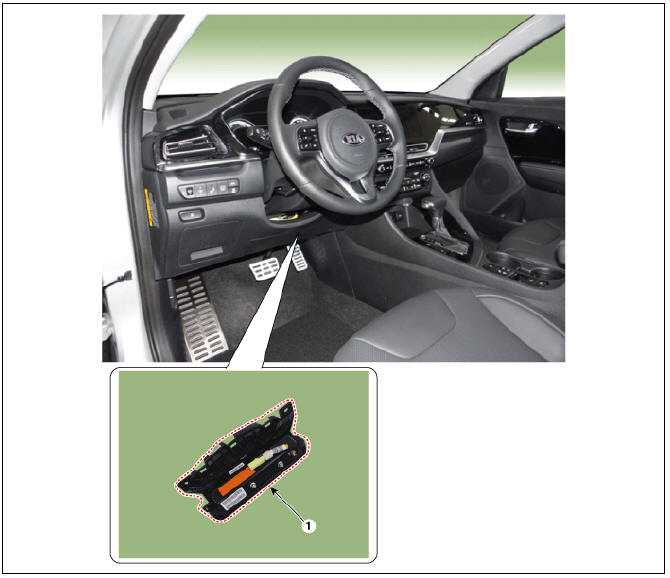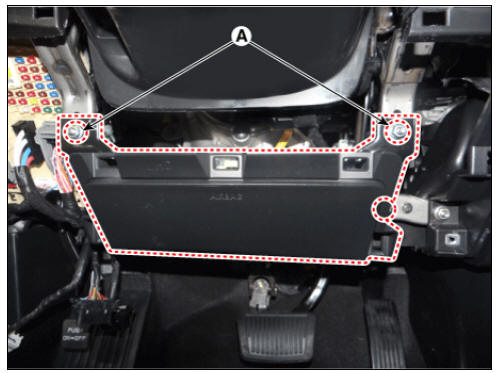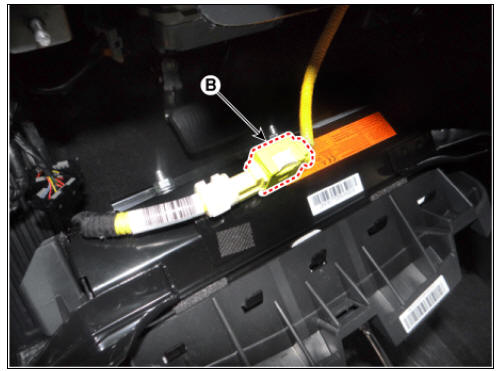KIA Niro: Knee Air Bag (KAB) | Airbag Module Disposal Description and operation
Description
The Knee Airbag (KAB) is installed inside the crash pad lower panel and protects the driver in the event of a frontal crash. The SRSCM determines if and when to deploy the KAB.
Warning
Never attempt to measure the circuit resistance of the airbag module (squib) even if you are using a specified tester. If the circuit resistance is measured with a tester, accidental airbag deployment will result in serious personal injury.
Components Location

- Knee Air Bag (KAB)
Removal
- Disconnect the battery negative cable, and wait for at least three minutes before beginning to work.
- Remove the crash pad lower panel.
(Refer to Body - "Crash Pad Lower Panel")
- Loosen the nuts (A) and then disconnect the connector (B).



Installation
- Disconnect the battery negative cable, and wait for at least three minutes before beginning to work.
- Install the knee air bag.
Tightning torque Bolts : 7.8 - 11.8 N*m (0.8 - 1.2 kgf*m, 5.8 - 8.7 lb*ft)
- Install the crash pad lower panel.
(Refer to Body - "Crash Pad Lower Panel")
- Reconnect the battery negative cable.
- After installing the knee air bag (KAB), confirm proper system operation:
- Turn the ignition switch ON; the SRS indicator light should be turned on for about six seconds and then go off.
Airbag Module Disposal Description and operation
Airbag Disposal
Special tool required
Deployment tool 0957A-34100A
Before scrapping any airbags or side airbags (including those in a whole vehicle to be scrapped), the airbags or side airbags must be deployed. If the vehicle is still within the warranty period, before deploying the airbags or side airbags, the Technical Manager must give approval and/or special instruction. Only after the airbags or side airbags have been deployed (as the result of vehicle collision, for example), can they be scrapped. If the airbags or side airbags appear intact (not deployed), treat them with extreme caution. Follow this procedure.
Deploying airbags in the vehicle
If an SRS equipped vehicle is to be entirely scrapped, its airbags or side airbags should be deployed while still in the vehicle. The airbags or side airbags should not be considered as salvageable parts and should never be installed in another vehicle.
- Turn the ignition switch OFF, and disconnect the battery negative terminal and wait at least three minutes.
- Confirm that each airbag or side airbag is securely mounted.
- Confirm that the special tool is functioning properly by following the check procedure.
(1) Driver's Airbag :
- Remove the driver's airbag and install the SST (0K57A-3U100A).
- Install the driver's airbag on the steering wheel.
(2) Front Passenger's Airbag :
- Remove the glove box housing, and then disconnect the connector between the front passenger's airbag and SRS main harness.
- Install the SST((0K57A-3U100A).
(3) Side Airbag :
- Disconnect the 2P connector between the side airbag and wire harness.
- Install the SST (0957A-2W100).
(4) Curtain Airbag :
- Disconnect the 2P connector between the curtain airbag and wire harness.
- Install the SST(OK57A-3U100A).
(5) Seat Belt Pretensioner :
- Disconnect the 2P connector from the seat belt pretensioner.
- Install the SST (OK57A-3U100A).
(6) Emergency Fastening Device :
- Disconnect the 2P connector from the anchor pretensioner.
- Install the SST (OK57A-3U100A).
- Place the deployment tool at least thirty feet (10meters) away from the airbag.
- Connect a 12 volt battery to the tool.
- Push the tool's deployment switch. The airbag should deploy (deployment is both highly audible and visible: a loud noise and rapid inflation of the bag, followed by slow deflation)
- Dispose of the complete airbag. No parts can be reused. Place it in a sturdy plastic bag and seal it securely.
Deploying the airbag out of the vehicle
If an intact airbag has been removed from a scrapped vehicle, or has been found defective or damage during transit, storage or service, it should be deployed as follows:
- Confirm that the special is functioning properly by following the check procedure on this page.
- Position the airbag facing up and EFD (Emergency Fastening Device) and Active Hood Actuator must be placed in piled up, at least, 5 tires, outdoors on flat ground at least thirty feet (10meters) from any obstacles or people.
- Connect a 12 volt battery to the tool.
- Push the tool's deployment switch. The airbag should deploy (deployment is both highly audible and visible: a loud noise and rapid inflation of the bag, followed by slow deflation)
- Dispose of the complete airbag. No parts can be reused. Place it in a sturdy plastic bag and seal it securely.
Warning
- When EFD and Active Hood Actuator are deployed, broken parts are exploded and scattered.
- EFD and Active Hood Actuator must be placed in the piled up 5 tires to avoid exploded broken parts.
- Technicians should wear an eye protector and extremely be cautions of exploded broken parts.
Disposal of damaged airbag
- If installed in a vehicle, follow the removal procedure of driver's airbag front passenger's and side airbag.
- In all cases, make a short circuit by twisting together the two airbag inflator wires.
- Package the airbag in exactly the same packing that the new replacement part come in.
READ NEXT:
 Seat Belt System
Seat Belt System
Pretensioner (BPT) / Description And Operation
The Seat Belt Pretensioners (BPT) are installed inside Center Pillar (LH &
RH). When a vehicle
crashes with a certain degree of frontal impact, the pretensioner seat belt
helps to reduce the se
SEE MORE:
 Front Seat Back Cover
Front Seat Back Cover
Front seat back cover
Replacement
Remove the front seat assembly.
(Refer to Front Seat - "Front Seat Assembly")
Remove the front seat outer shield cover.
(Refer to Front Seat - "Front Seat Outer Shield Cover")
 Tire sidewall labeling
Tire sidewall labeling
This information identifies and describes
the fundamental characteristics of the
tire and also provides the tire identification
number (TIN) for safety standard
certification. The TIN can be used to
identify the tire in case of a recall.
Categories
- Home
- KIA Niro EV, Hybrid - Second generation - (SG2) (2021-2024) - Owner's manual
- Kia Niro - First generation - (DE) (2017-2022) - Service and Repair Manual
- Contact Us
